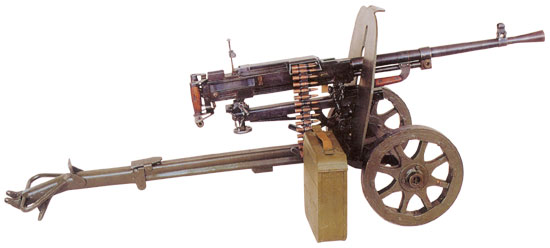
The SG43 was designed by P.M. Goryunovin 1942 to provide a wartime replacement for the elderly Maxim Model 1910, and even used the old Maxim’s wheeled carriage.
The Degtyerev DP Model 1928 was a major Soviet light machine-gun during World War II. Simple and robust, the DP could stand rough treatment and extremes of weather. It can still be found in the hands of guerrilla groups all over the world.
The Soviets entered the war with a mix of medium Maxims and light Degtyarevs, with the DShK being produced to replace the Maxims. However, when the Red Army attacked Finland in the 1939 Winter War, its DP and DT machine guns did not operate as well as hoped in the cold environment. They experienced major problems, especially the failure of return springs. Several quick fixes were tried but proved unsatisfactory. Eventually, the spring design and placement were radically changed; the resulting weapons were designated the DP Modernized (DPM). Similar changes were applied to the DT, resulting in the DTM, which was the tank and armored vehicle version.
Other modifications and revisions were made in the early years of the war, including converting them to belt-feed, but this made the DPM too heavy, and the long, flapping ammunition belt was a nuisance to the gunner when sprinting to a new position. It is suspected that the DPM was merely a stopgap pending the development of better weapons.
While production of the DPM continued, the Soviets put engineers to work developing a new 7.62mm LMG. A number of designers, including Vasily Degtyarev, Sergei Simonov, and Mikhail Kalashnikov (his first appearance as a designer; he would later become famous for his assault rifle), participated in this competition. Degtyarev offered two gas-operated guns, one belt-fed and the other with a top-mounted box magazine. Simonov designed a gas-operated weapon. Kalashnikov presented a short-recoil design. The Simonov design was selected after initial trials, but the weapon was neither durable nor accurate.
By the middle of 1943, the Soviets had developed a new short cartridge, the 7.62x39mm, and this led to a rethinking of the LMG concept in the Red Army.
Although the new round had been developed for the assault rifle, it was accurate out to 800 meters, sufficient for the squad light automatic weapon. A call went out for designs using the new cartridge. A number were submitted, and after trials the Degtyarev entry was selected. It was approved in 1944 as the RPD (Ruchnyy Pulyemet Systema Degtyarev—Light Machine Gun by Degtyarev).
The RPD was a derivative of the earlier DP and DPM models but was belt-fed from a drum clipped beneath the gun. For the first time, Soviet infantrymen had a machine gun that they could pick up and use in the assault. Unlike most LMGs, it had a fixed barrel, and the gunner had to be careful to avoid firing more than 100 rounds in one minute to prevent overheating. The war ended before this weapon could be perfected. It would go into full production in 1953 and proved to be a rugged and effective design; it became the standard squad automatic weapon for the Red Army and for Soviet client states.
The Soviets also developed a medium machine gun during World War II. The Degtyarev DS MMG had proved a failure in service, and production was halted in 1941. The Red Army reverted to the Maxim M1910, but when the Germans attacked in OPERATION BARBAROSSA, the supply of machine guns was woefully inadequate. The choices were to build more factories to turn out more of the older model, or to come up with an entirely new design. Pyotr Goryunov had already been working on a medium, and in June 1941 he demonstrated his design to the military. He was instructed to make 50 guns for extensive testing, including some sent to front-line units. The reports were favorable; after some revisions and more tests, it was adopted in May 1943 as the 7.62mm Stankovyi Goryunova 43 (SG43). The SG43 was gas-operated and air-cooled. It was fed by belt and was usually mounted on a wheeled carriage similar to that used with the Maxim 1910. During the Winter War of 1944 against Finland, the SG43 was mounted on a sled for easier movement over snow. It is extremely heavy but was very good for use in the defense. This gun was manufactured in some numbers during the war but never entirely replaced the PM1910, which stayed in production right till war’s end and remained in front-line service with the Soviet Army into the 1980s.
The Soviets also used the 12.7mm DShK HMG during World War II. It had originally been employed primarily as an antiaircraft weapon, but by 1943 it was in wide use in the infantry support role. With the increase in usage, problems with the weapon became apparent; chief among these was a feed problem. Modifications were made to the Shpagin feed system, and various other parts were strengthened, making the gun easier to manufacture, more reliable, and less likely to jam. The new model was designated the DShKM 38/46.